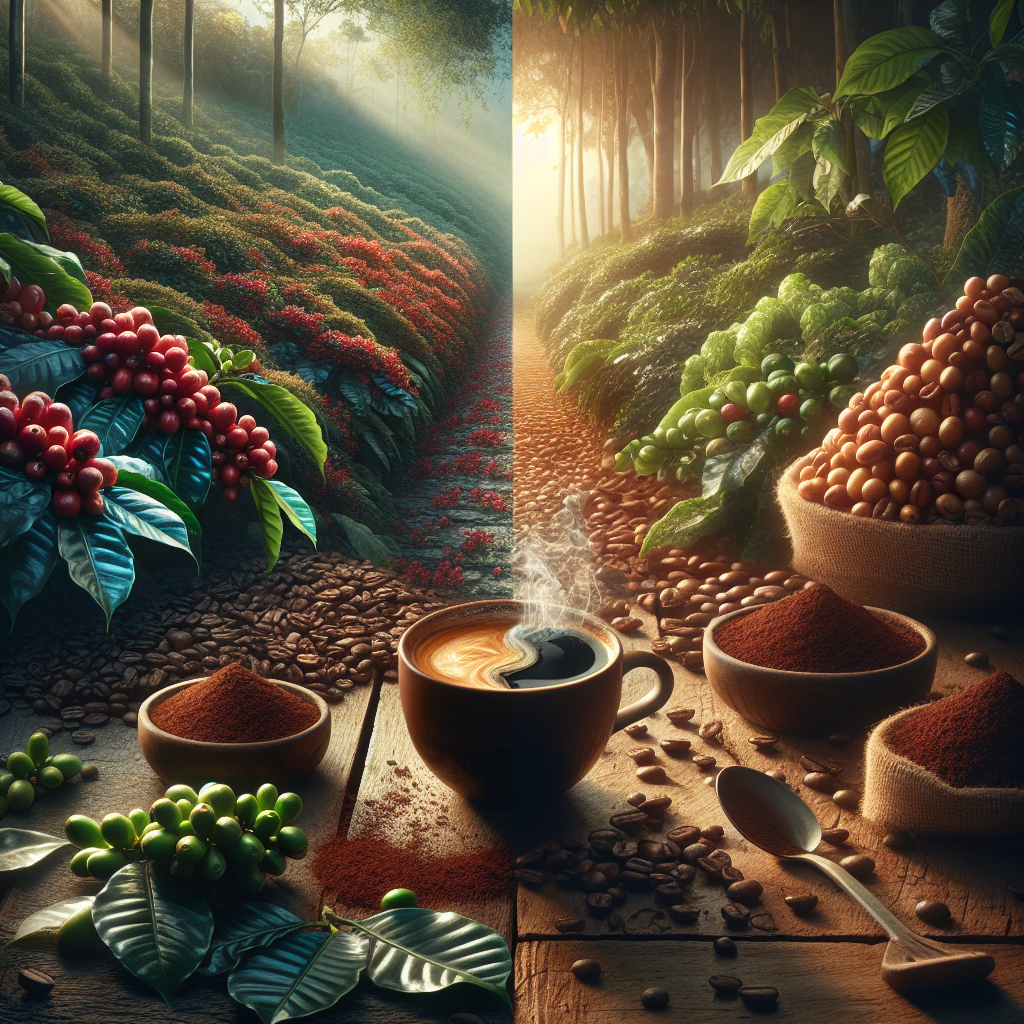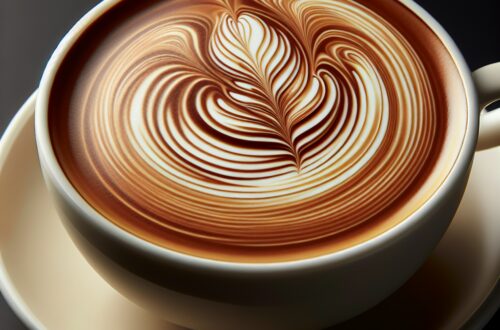“`html
Understanding the Differences Between Arabica and Robusta Coffee Beans
Exploring the world of coffee often begins with understanding the key differences between Arabica and Robusta beans. These two varieties of coffee represent different flavor profiles, growing conditions, and market preferences, catering to a wide range of taste enthusiasts and commercial needs.
Origin and Popularity of Coffee Beans
| Type of Coffee | Origin | Global Production Share | Popularity |
|---|---|---|---|
| Arabica | Ethiopia, Coffea arabica plant | 60-80% | Most popular variety worldwide |
| Robusta | Central and Western Sub-Saharan Africa, Coffea canephora plant | 20-25% | Less popular but crucial for blends |
Origin and Popularity
The origin and popularity of coffee beans underpin the global coffee culture. Arabica coffee, derived from the Coffea arabica plant, was first discovered in Ethiopia. Known for its superior quality, Arabica accounts for a substantial 60-80% of global coffee production, making it the most favored coffee variety worldwide.
On the other hand, Robusta coffee comes from the Coffea canephora plant and originated in central and western sub-Saharan Africa, particularly in regions like Uganda. Despite being less popular, Robusta still holds a critical share of about 20-25% of the world’s coffee market. Its unique attributes make it an essential part of many coffee blends.
Flavor Profile
One of the key differences between Arabica and Robusta lies in their flavor profiles. Arabica beans are renowned for their smooth and sweet taste, with common flavor notes including chocolate, sugar, and sometimes fruity undertones. This complexity and sweetness make Arabica the preferred choice among coffee connoisseurs and specialty coffee enthusiasts.
In contrast, Robusta beans are characterized by a stronger, more bitter flavor profile. Often described as earthy, nutty, or woody, the robust flavor of Robusta is especially prominent in espresso blends, where it adds depth and a distinct crema. While Arabica is celebrated for its nuanced flavors, Robusta’s strong taste is less favored for single-origin preferences but valuable in blends.
Caffeine Content
Caffeine content is a significant factor distinguishing Arabica and Robusta beans. Robusta beans contain a higher caffeine content, approximately 2.7%, compared to Arabica beans, which usually have about 1.5% caffeine. This higher caffeine level in Robusta contributes to its robust and intense flavor, as well as its natural resistance to pests.
Arabica’s lower caffeine content results in a smoother taste, preferred by those who enjoy a balanced cup without the jittery effects associated with high caffeine intake. Therefore, the choice between these beans often depends on the desired strength and flavor of the coffee.
Shape and Appearance
The physical characteristics of Arabica and Robusta beans are distinctive. Arabica beans are oval and elongated, typically featuring a curved crease on one flat side. They tend to be a lighter brown color when raw. In contrast, Robusta beans are rounder and more stout, often with a straight crease. Their raw color is generally darker than Arabica beans.
These shape and appearance differences are important for processing but do not directly influence the quality of the coffee. They serve as visual cues that help differentiate between the bean types during sorting and preparation.
Growing Conditions
The growing conditions for Arabica and Robusta beans significantly impact their characteristics. Arabica coffee is cultivated at higher elevations, typically between 3,000 to 6,000 feet. These higher-altitude environments contribute to the complex flavors of Arabica. However, the specific and controlled conditions required for Arabica make it less hardy and more susceptible to pests and diseases.
On the contrary, Robusta coffee thrives at lower altitudes and is more tolerant of harsh growing conditions. This resilience makes Robusta easier to cultivate across various environments, ensuring a higher yield despite less favorable conditions.
Yield and Cultivation
A notable difference between Arabica and Robusta lies in their yield and ease of cultivation. Robusta plants generally produce higher yields than Arabica plants, making them more commercially appealing due to lower production costs. The robust nature of Robusta allows for mechanical harvesting, reducing labor costs significantly.
Although Arabica beans yield less per tree, they are prized for their superior quality and complex flavors, which make them highly sought after in premium coffee markets. Cultivating Arabica is labor-intensive, often requiring selective picking due to the challenging terrains and growing conditions.
Aroma and Acidity
The aroma and acidity of coffee beans are crucial elements of their overall profile. Arabica beans are celebrated for their well-developed and pleasant aroma, which can range from floral to fruity, depending on the region and processing methods. They also possess higher acidity levels, contributing to a bright, winey tone that adds depth and complexity.
In comparison, Robusta beans generally have a less appealing aroma, often described as woody or earthy. Their lower acidity leads to a more straightforward and robust flavor, which is less complex but still essential for certain coffee blends.
Price Point
The price disparity between Arabica and Robusta is influenced by their quality, growing conditions, and yield. Arabica coffee is typically more expensive due to its superior quality, complex flavors, and the labor-intensive cultivation process. These factors position Arabica as a premium product within specialty coffee markets.
On the other hand, Robusta coffee is generally less costly, owing to its higher yield and easier cultivation. This price difference plays a significant role in consumer decisions and market dynamics, impacting both producers and the sustainability of coffee farming industries.
In summary, the choice between Arabica and Robusta beans boils down to personal preferences regarding flavor, caffeine content, price, and desired coffee experience. Each bean type offers unique attributes that cater to diverse tastes and brewing methods. Dive deeper into the fascinating world of coffee by exploring more FAQs here, and enrich your knowledge of this beloved beverage.
“`
Shop at Breville now!
https://breville.oie8.net/oqDqrE
Shop Coffee Machine at Amazon now!
Click here!





